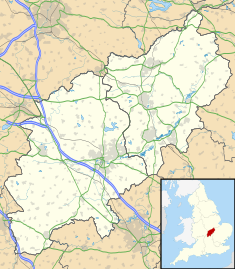The Council Buildings are based in Newton Road, Rushden, Northamptonshire, England. The structure, which was the headquarters of Rushden Urban District Council, is a locally listed building.[1]
| Council Buildings | |
|---|---|
 Council Buildings, Rushden | |
| Location | Newton Road, Rushden |
| Coordinates | 52°17′21″N 0°35′46″W / 52.2891°N 0.5960°W |
| Built | 1906 |
| Architect | William Madin |
| Architectural style(s) | Renaissance style |
History
editFollowing significant population growth, partly associated with the local boot and shoe making industry, the area became an urban district in 1895.[2] The council held its early meetings in the local vestry hall.[3] However, in the early 20th century, civic leaders decided to procure purpose-built council buildings: the site they chose was open land on the south side of what was then Church Lane (later renamed Newton Road).[4] The vestry hall, which had been owned by the local board, was subsequently sold to St Mary's Church[5] and the proceeds applied towards repaying funds borrowed to finance the cost of the new building.[6]
The new building was designed by William Madin in the Renaissance style, built in red brick with stone dressings by a local contractor, R. Marriott, and was officially opened on 19 December 1906.[7] The design involved a symmetrical frontage at the junction of Newton Road and Park Road; the corner section featured a doorway flanked by Doric order columns supporting an entablature inscribed with the words "Council Buildings"; on the first floor there was a curved stone balcony with a balustrade bearing the town's coat of arms and a recessed French door with an arched surround; the section was flanked by full-height octagonal turrets and there was a gable at roof level. Internally, the principal rooms were the council chamber and the offices of the town surveyor and the sanitary inspector.[6] A second storey was added to the Newton Road elevation of the building in 1934.[6]
The council buildings continued to serve as the headquarters of Rushden Urban District Council for much of the 20th century and initially remained the meeting place of the enlarged East Northamptonshire District Council after it was formed in 1974.[8][9] The district council moved to temporary offices in Thrapston in the mid-1980s,[10] but continued to use the Rushden building as a customer service centre for locally delivered services such as housing benefits.[6][11]
A programme of improvement works, which included the construction of a glass atrium connecting the council buildings with the adjacent Carnegie Library, was carried out in the mid-1990s.[12] The works also included the creation of a heritage centre, on the first floor of the council buildings, which was officially opened by the Chairman of East Northamptonshire District Council, Councillor Ted Sampson, in October 1995.[12] After putting on a series of exhibitions with local themes, the heritage centre closed in 2006.[12]
References
edit- ^ "Local List of Heritage Assets". East Northamptonshire District Council. 22 July 2013. p. 5. Retrieved 22 April 2021.
- ^ "Rushden UD". Vision of Britain. Retrieved 22 April 2021.
- ^ "Rushden in September 1919". Rushden Museum. Retrieved 22 April 2021.
- ^ "Ordnance Survey Map". 1885. Retrieved 22 April 2021.
- ^ "Proposed Sale of Rushden Vestry Hall". The Rushden Echo. 20 January 1905. Retrieved 22 April 2021.
- ^ a b c d "Rushden Urban Council Building". Rushden and District History Society. Retrieved 22 April 2021.
- ^ Municipal Buildings, Rushden. The Builder. 5 January 1907. p. 17.
- ^ Local Government Act 1972. 1972 c.70. The Stationery Office Ltd. 1997. ISBN 0-10-547072-4.
- ^ "No. 48664". The London Gazette. 19 June 1981. p. 8694.
- ^ "Celebrating 47 Years of East Northamptonshire District Council". East Northamptonshire District Council. p. 5. Retrieved 22 April 2021.
- ^ "Customer Services". North Northamptonshire District Council. Retrieved 22 April 2021.
- ^ a b c "Friends of Rushden Heritage Centre". Rushden and District History Society. Retrieved 22 April 2021.
